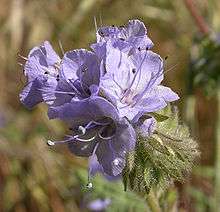Phacelia tanacetifolia
| Phacelia tanacetifolia | |
|---|---|
 | |
| Scientific classification | |
| Kingdom: | Plantae |
| (unranked): | Angiosperms |
| (unranked): | Eudicots |
| (unranked): | Asterids |
| Order: | (unplaced) |
| Family: | Boraginaceae |
| Genus: | Phacelia |
| Species: | P. tanacetifolia |
| Binomial name | |
| Phacelia tanacetifolia Benth. | |
Phacelia tanacetifolia is a species of phacelia known by the common names lacy phacelia, blue tansy or purple tansy.
Range and uses
Beneficial insects
It was originally native to the Southwestern United States and northern Mexico,[1] but it is now used in many places in agriculture as a cover crop, a bee plant, an attractant for other beneficial insects, as a green manure [2] and an ornamental plant. It is planted in vineyards and alongside crop fields, where it is valued for its long, coiling inflorescences of nectar-rich flowers which open in sequence, giving a long flowering period.[3] It is a good insectary plant, attracting pollinators such as honey bees.[3]
Biological pest control
It is also attractive to hoverflies (family Syrphidae), which are useful as biological pest control agents because they eat aphids and other pests.[4]
Description
This is an annual herb which grows erect to a maximum height near 100 centimeters. The wild form is glandular and coated in stiff hairs. The leaves are mostly divided into smaller leaflets deeply and intricately cut into toothed lobes, giving them a lacy appearance. The very hairy inflorescence is a one-sided curving or coiling cyme of bell-shaped flowers in shades of blue and lavender. Each flower is just under a centimeter long and has protruding whiskery stamens.
The seeds are "negatively photoblastic", or photodormant, and will only germinate in darkness.[5]
| Wikimedia Commons has media related to Phacelia tanacetifolia. |
References
- ↑ GRIN Species Profile
- ↑ "Green Manure". RHS. Retrieved 15 October 2015.
- 1 2 Phacelia tanacetifolia: A brief overview of a potentially useful insectary plant and cover crop. Small Farm Fact Sheet.
- ↑ Hickman, J. M. & W. D. Wratten. (1996). Use of Phacelia tanacetifolia strips to enhance biological control of aphids by hoverfly larvae in cereal fields. Journal of Economic Entomology 89:4 832-40.
- ↑ Serrato-Valenti, S., et al. (1998). A histological and structural study of Phacelia tanacetifolia endosperm in developing, mature, and germinating seed. International Journal of Plant Sciences 159:5 753-61.
External links
| Wikimedia Commons has media related to Phacelia tanacetifolia. |